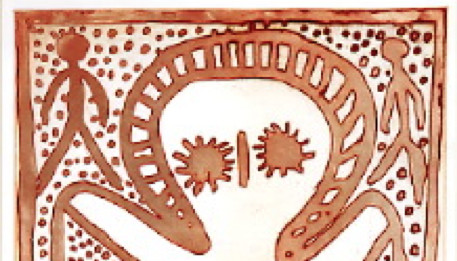
Lily Karedada's Wandjina (Wanjina) Spirit Figure, Kimberley. Palya Art Tours leaves to fly over ...
Leaving on Monday, Palya Art Tours flies across Kimberley, landing to speak with artists across this vast and beautiful land.
Increasingly, Kimberley art is being recognised across the world. One Kimberley artist, Lily Karedada - her embossed Wandjina figure on paper seen above - was awarded with the Australian Centenary Medal for Contribution to Art in 2003
The Wandjina and Lily Karedada: According to I.M. Crawford in his 1968 book The Art of the Wandjina, Wandjina represent the ‘spirit in the cloud’, the force within a thunderhead, with both human and cloud-like characteristics. The headress worn by Wandjina is said to be both the headdress and the cloud itself, and the patterning within the headdress the thunder emanating from the cloud; it is in this way that the cumulonimbus clouds that herald the arrival of the annual monsoon are given human form. John E Stanton, Art & Australia, Vol.43, No.3, 2006.
"Lily specialises in representations of Wandjina executed in a refined style, full of subtle tonal variations. Sometimes the Wandjina is shown emerging from a veil of dots (rain) which also inundate his body. Both the outlines and the dotting are far more precise than the vigorous gestural marks of sister-in-law Roslyn Karedada. A dotted ground is also characteristic of Lily's depiction of totemic species and the natural features of her country." Source Judith Ryan National Gallery of Victoria.
"Lily Karedada, a polite, resourceful woman, lived in the far north Kimberley region of Western Australia. Born on her Father's country 'Woombangoo-wan-goor' (Prince Regent River area) she and her family spoke the Wunambal language. Lily met and married Jack Karedada before leaving 'the bush' during World War 11 to settle in Kalumburu, a trading and Mission settlement that went on to be bombed. Together Jack and Lily had ten children, worked at the Mission and industriously painted Wandjina (Wanjina), bush foods and hunting implements, celebrating and sharing their land, life and culture. Helen Read
Principal at Eagle & Partners
7yI recently saw a very Wandjina-like spirit figure depicted in the work of an indigenous artist from Mosman, Far North Queensland, the main difference being a mermaid-like lower portion, instead of legs. These spirits were regarded as benign or helpful spirits to protect people during darkness hours. They were inspired by owls. Given that Wandjinas are conceived as short beings (I understand that Donnie Woolmagoodja thinks of them as being about waist-high), then owls could conceivably be the inspiration for the Wandjina.